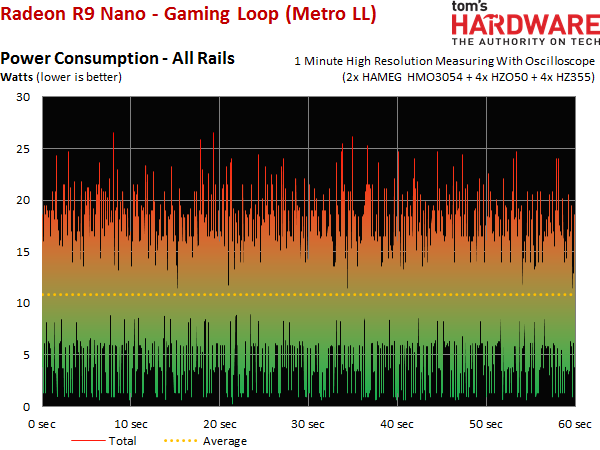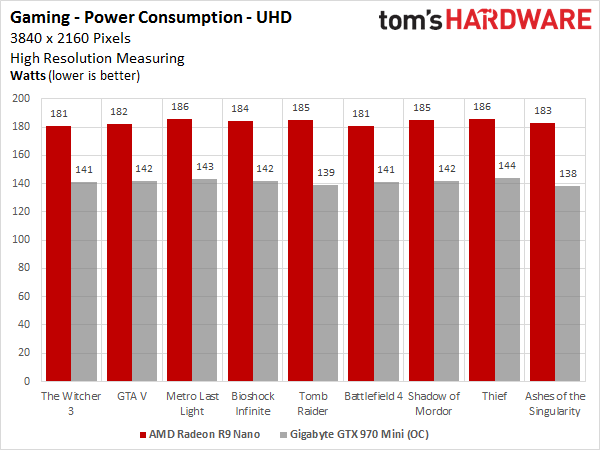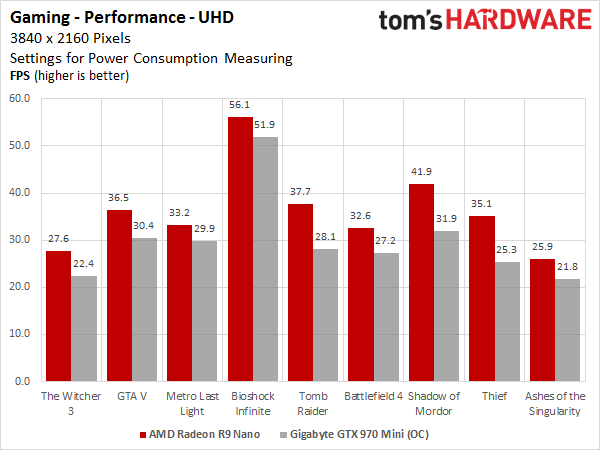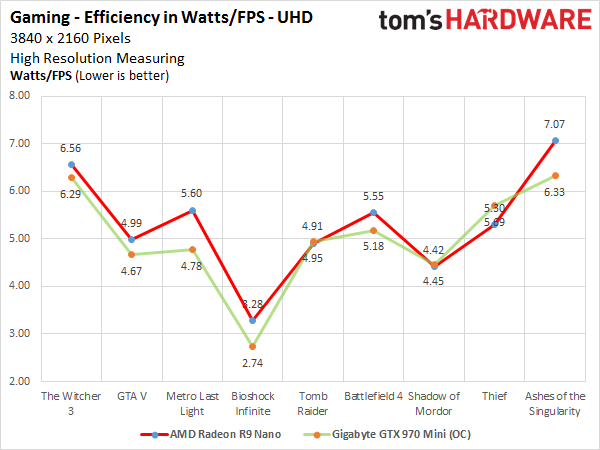AMD Radeon R9 Nano Review
Small, fast and pricey — that’s how AMD wants to establish a whole new product category. But does the Radeon R9 Nano have the performance to back up its price tag?
Results: Power Consumption And Efficiency
Idle/2D Desktop
We aren’t going to spent a lot of time in this section since very little changes from the Radeon R9 Fury X. The Nano’s pleasantly low power consumption of 10 to 12W at idle is one of the best results we’ve ever measured for an AMD graphics card in this performance range. Multiple monitors don’t change the story either, similar to what we saw from the Fury X.
| Header Cell - Column 0 | Minimum | Maximum | Average |
|---|---|---|---|
| PCIe | 1W | 21W | 7W |
| Motherboard 3.3V | 0W | 2W | 1W |
| Motherboard 12V | 0W | 11W | 3W |
| Graphics Card Overall | 1W | 27W | 11W |
Gaming / 3D Operation
Here's where the story gets more interesting. AMD states a typical power consumption of 175W. With a cold card, we actually hit this number, which is great if you’re living in northern Alaska and love to keep your windows open. For everybody else, AMD's specifications prove elusive as soon as a full load, 4K resolution and a warm card come into play. The additional 8W of leakage current doesn't sour us on the Nano's power result, though.
Let’s take a look at the power numbers we measured across the entire benchmark suite and compare them to Nvidia's GTX 970 Mini (OC).
The highest power consumption was reported in Metro Last Light and Thief. We used long scenes for those measurements, not just short sections with uncharacteristically high spikes. Our reasoning will become clear in the stress test section below.
But let’s go back to gaming. We’re puzzled by the bars’ evenness. It’s not a secret that Nvidia’s GPU Boost is restrictive when it comes to hitting power targets. Up until now, AMD seemed fairly contrarian. But these results make it look like AMD is putting its foot down as well. You no longer see bursts of power consumption in certain scenes.
What about the gaming performance to go along with these figures? We just saw that AMD's Radeon R9 Nano consumes more power than the GTX 970 Mini (OC) on average. Putting this into context with frame rates gives those numbers a different spin.
It turns out that the Radeon R9 Nano uses more power, but also provides more performance than the Nvidia GTX 970 Mini (OC). So what happens if we calculate the ratio of the two numbers to get watts per FPS?
Get Tom's Hardware's best news and in-depth reviews, straight to your inbox.
No doubt, the resulting graph will cause a lot of head-scratching. The Nano’s efficiency is better in one game, similar in two games and not far behind in all the other games compared to Nvidia's GeForce GTX 970 Mini (OC). The exception is Ashes of the Singularity, and the reason why was covered on the previous page. Here’s the efficiency graph:
There’s simply no comparing this to the Radeon R9 Fury X or AMD’s Hawaii-based graphics cards. AMD is declaring war on power companies, it seems. Power Tune with a real and restrictive limit finally works like it’s supposed to.
For those who like their details, we’re also showing the usual gaming loop measurements. The individual rails’ power consumption numbers, including peaks, can be found right here:
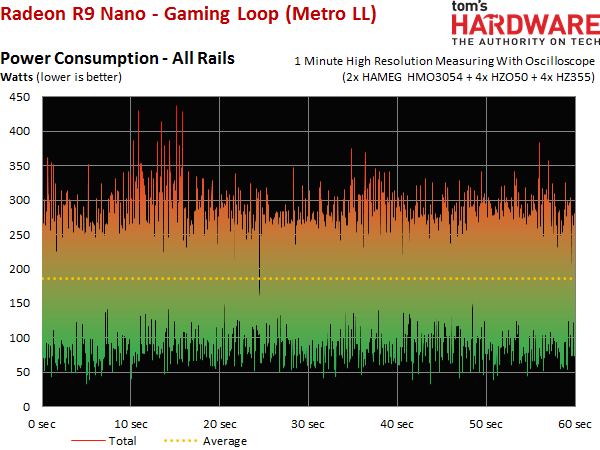
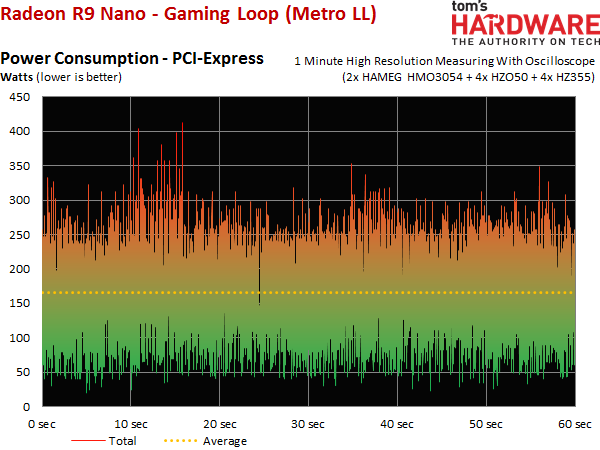
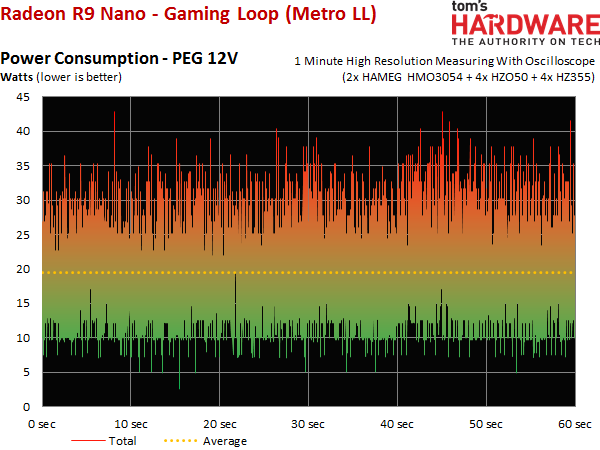
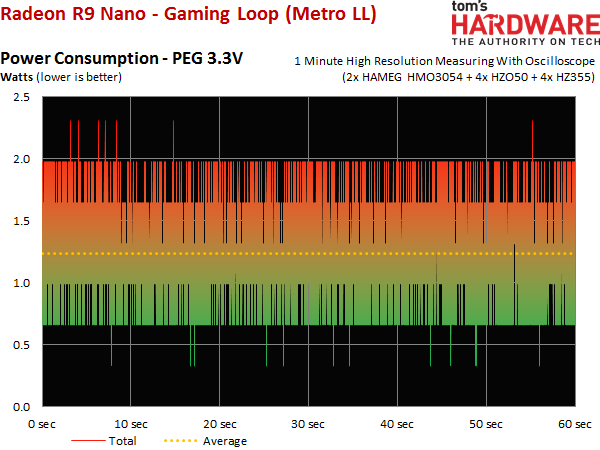
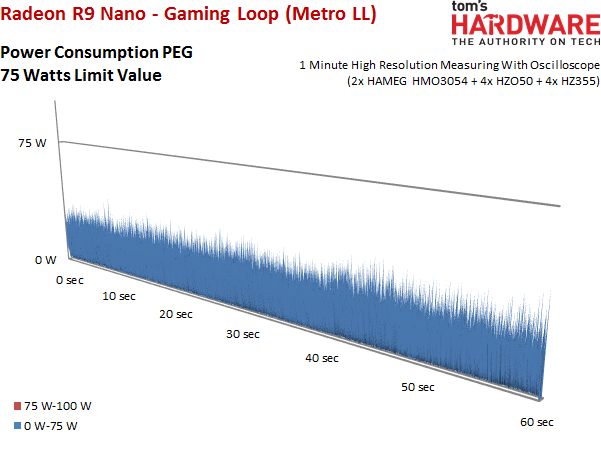
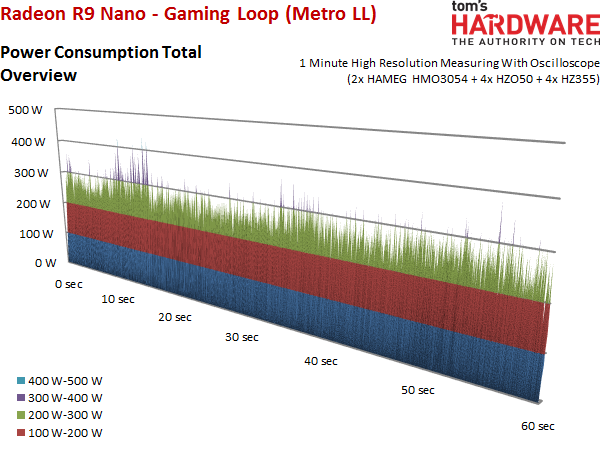
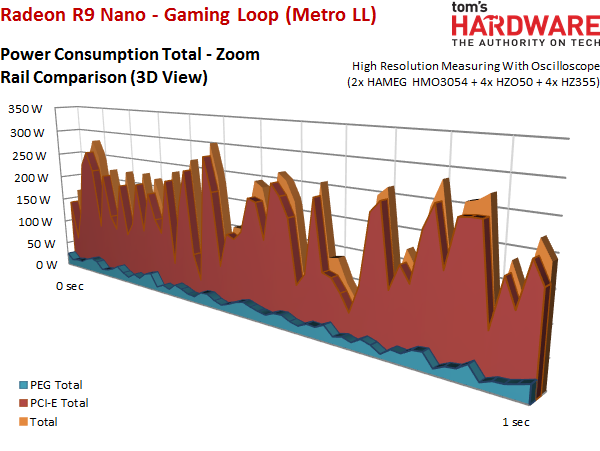
| Minimum | Maximum | Average | |
|---|---|---|---|
| PCIe | 20W | 413W | 165W |
| Motherboard 3.3V | 0W | 2W | 1W |
| Motherboard 12V | 3W | 43W | 19W |
| Graphics Card Overall | 33W | 437W | 186W |
A Stress Test that’s Really Not a Stress Test
This used to be where older Radeon cards were pushed to the point of glowing red-hot. Power Tune put an end to all of that though, so try as you might, you can't use your graphics card as a space heater any longer. First let's look at the curves:
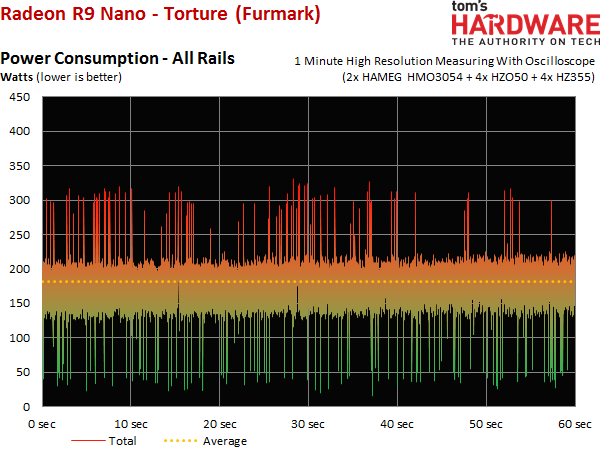
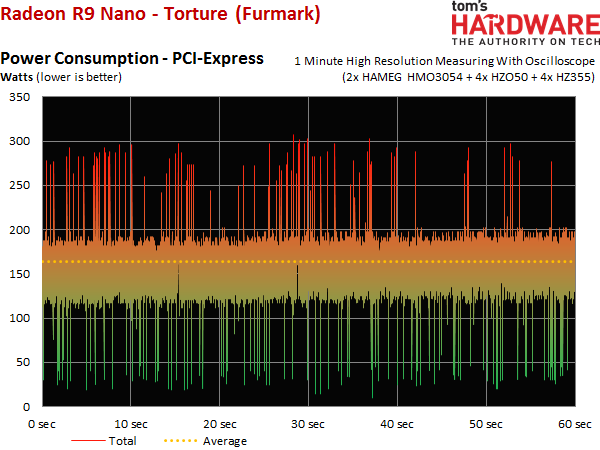
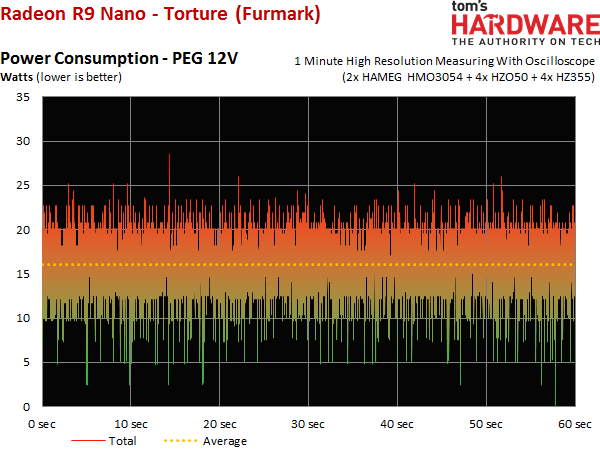
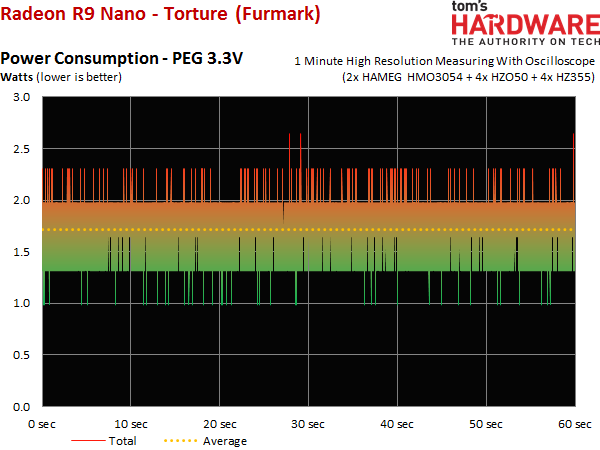
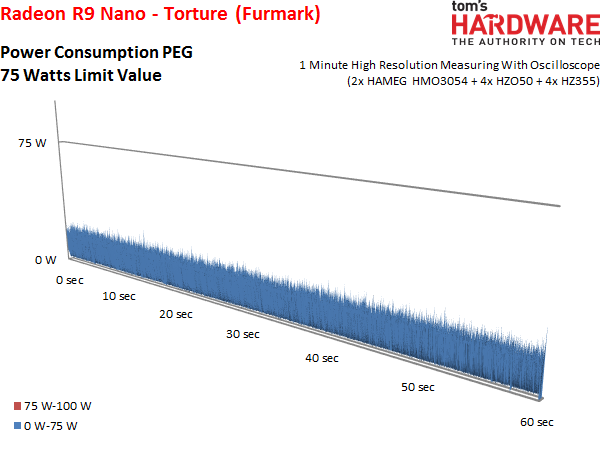
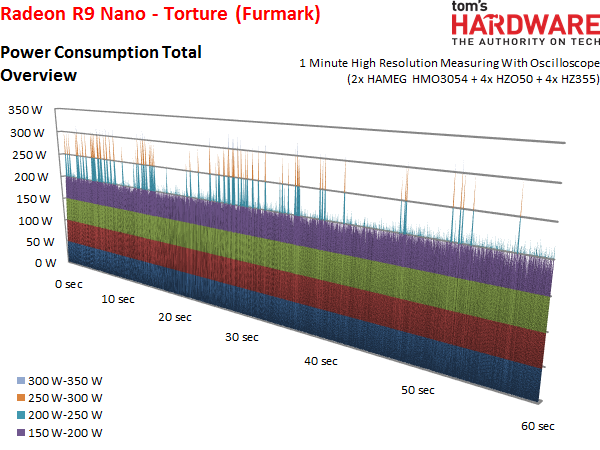
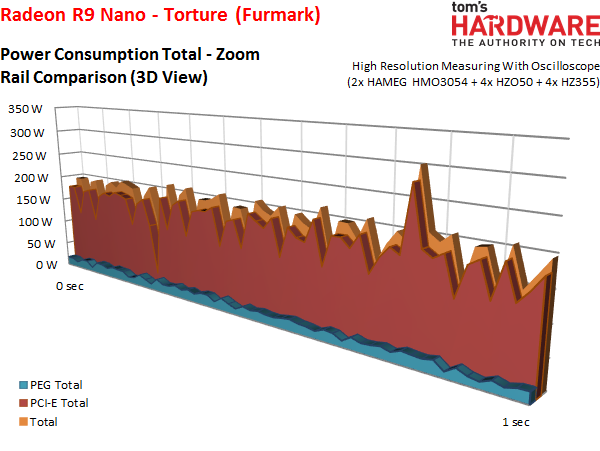
The Radeon R9 Nano’s power consumption is actually slightly lower during the stress test than some of our gaming benchmarks due to a constant load that pushes clock rates down quite a bit.
| Header Cell - Column 0 | Minimum | Maximum | Average |
|---|---|---|---|
| PCIe | 10W | 307W | 164W |
| Motherboard 3.3V | 1W | 3W | 2W |
| Motherboard 12V | 0W | 29W | 16W |
| Graphics Card Overall | 16W | 332W | 182W |
Power Consumption Overview
Current page: Results: Power Consumption And Efficiency
Prev Page Results (DirectX 12): Ashes Of The Singularity Next Page Results: Frequencies And Temperatures
Igor Wallossek wrote a wide variety of hardware articles for Tom's Hardware, with a strong focus on technical analysis and in-depth reviews. His contributions have spanned a broad spectrum of PC components, including GPUs, CPUs, workstations, and PC builds. His insightful articles provide readers with detailed knowledge to make informed decisions in the ever-evolving tech landscape
-
Eximo Looks like the table had a hiccup. GTX970 (OC) is showing a lot of the numbers from the R9-390X, and maybe a few numbers from the 980 column.Reply -
-Fran- It is a nice card and I agree, but... It's not USD $650 nice.Reply
This card is a very tough sell for AMD, specially since ITX cases that can house current long cards are not hard to find or weird enough to make short cards a thing.
It's nice to see it's up there with the GTX970 in terms of efficiency, since HTPCs need that to be viable and the card has no apparent shortcomings from what I could read here.
All in all, it needs to drop a bit in price. It's not "650 nice", but making it "~500 nice" sounds way better. Specially when the 970 mini is at 400.
Cheers! -
sna no HDMI2.0 in itx small system near the 4k TV is unforgivable AMD , what were you thinking?Reply -
sna Reply16605176 said:It is a nice card and I agree, but... It's not USD $650 nice.
This card is a very tough sell for AMD, specially since ITX cases that can house current long cards are not hard to find or weird enough to make short cards a thing.
It's nice to see it's up there with the GTX970 in terms of efficiency, since HTPCs need that to be viable and the card has no apparent shortcomings from what I could read here.
All in all, it needs to drop a bit in price. It's not "650 nice", but making it "~500 nice" sounds way better. Specially when the 970 mini is at 400.
Cheers!
well this card is for the smallest case ... not the easy to find huge long itx case.
I personaly find long itx cases useless ... they are very near to Matx case in size .. and people will pick up MATX ovet ITX any time if the size is the same.
BUT for 170mm long card ? this is a winner.
the only thing killing this product is the lack of HDMI2.0 which is very important for itx .. ITX are the console like PC near the tv.
-
heffeque Replyno HDMI2.0 in itx small system near the 4k TV is unforgivable AMD , what were you thinking?
I guess that they were thinking about DisplayPort? -
Nossy I'd go with the 950 GTX for a mini ITX build for a 1080pgaming/4k video HTPC.Reply
For a $650 bucks video card. I'd go with a 980TI and use a Raven RVZ01 if I want an ITX build with performance.
